| French Bulldog | |||||||||||||||||||||||||
|---|---|---|---|---|---|---|---|---|---|---|---|---|---|---|---|---|---|---|---|---|---|---|---|---|---|
 | |||||||||||||||||||||||||
| Other names | Bouledogue Français | ||||||||||||||||||||||||
| Origin | France[1] | ||||||||||||||||||||||||
| |||||||||||||||||||||||||
| |||||||||||||||||||||||||
| Dog (domestic dog) | |||||||||||||||||||||||||
The French Bulldog, French: Bouledogue Français, is a French breed of companion dog or toy dog. It appeared in Paris in the mid-nineteenth century, apparently the result of cross-breeding of Toy Bulldogs imported from England and local Parisian ratters.[4] It is commonly kept as a pet, and is among the most frequently registered dogs in a number of countries including Australia, the United Kingdom, and the United States. The breed is prone to significant health issues as a consequence of breeding for their distinctive appearance, especially the brachycephalic face and skin wrinkles.
History
From the beginning of the nineteenth century, bulldogs were bred in the United Kingdom for purposes other than traditional blood sports such as bull-baiting, which were banned in 1835.[5]: 5 By the middle of the century there were miniature bulldogs, often weighing some 7–11 kg (15–24 lb), though some weighed considerably less.[5]: 6
At the same time, lace workers from Nottingham who were displaced by the Industrial Revolution began to settle in Normandy, France.[6]: 58 They brought a variety of dogs with them, including Toy Bulldogs.[7] The dogs became popular in France and a trade in imported small Bulldogs was created, with breeders in England sending over Bulldogs that they considered to be too small, or with faults such as ears that stood up. By 1860, there were few Toy Bulldogs left in England, such was their popularity in France.[5]: 6
The small Bulldog type gradually became thought of as a breed, and received a name, the Bouledogue Francais.[5]: 6 This Francization of the English name is also a contraction of the words boule ('ball') and dogue ('mastiff'). The dogs were highly fashionable and were sought after by society ladies and Parisian prostitutes alike, as well as creatives such as artists, writers, and fashion designers.[5]: 6 The artists Edgar Degas and Henri de Toulouse-Lautrec are thought to have French Bulldogs in their paintings.[8] However, records were not kept of the breed's development as it diverged further away from its original Bulldog roots. As it changed, terrier stock had been brought in to develop traits such as the breed's long straight ears.[5]: 6
Depictions in nineteenth-century paintings
 Toulouse-Lautrec: Bouboule, Bull-dog de madame Palmyre, à la souris, 1897
Toulouse-Lautrec: Bouboule, Bull-dog de madame Palmyre, à la souris, 1897 A l'écurie, cheval et chien, Edgar Degas, about 1861
A l'écurie, cheval et chien, Edgar Degas, about 1861 Toulouse-Lautrec
Toulouse-Lautrec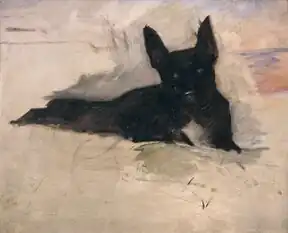 Toulouse-Lautrec
Toulouse-Lautrec
Breed clubs and modern recognition
Americans had been importing French Bulldogs for a while, but it was not until 1885 that they were brought over in order to set up an American-based breeding program. They were mostly owned by society ladies, who first displayed them at the Westminster Kennel Club Dog Show in 1896.[9] In the following year, the judge at the dog show, George Raper, only chose winners with "rose ears"—ears that folded at the tip, as with the standard for Bulldogs.[10] The ladies formed the French Bull Dog Club of America and created a breed standard which preferred the "erect bat ear" type.[5]: 7 In the early 20th century, the breed remained in vogue for high society, with dogs changing hands for up to $3,000 and being owned by members of influential families such as the Rockefellers and the J. P. Morgans. The American Kennel Club recognized the breed quickly after the breed club was formed, and by 1906 the French Bulldog was the fifth most popular dog breed in America.[5]: 8
This new Bulldog breed arrived for the first time in England in 1893, with English Bulldog breeders in an uproar as the French imports did not meet the new breed standards in place by this time, and they wanted to prevent the English stock from crossbreeding with the French. The Kennel Club initially recognized them as a subset of the existing Bulldog breed rather than an entirely new breed.[5]: 6 Some English breeders in this period bred the French Bulldogs in order to resurrect the Toy Bulldog.[6]: 58 On 10 July 1902, at the house of Frederick W. Cousens, a meeting was held to set up a breed club in order to seek individual recognition for the French breed.[5]: 7 The adopted breed standard was the same one which was already in use in America, France, Germany and Austria.[6]: 58 Despite opposition from Miniature Bulldog (the new breed name for the Toy Bulldog) and Bulldog breeders,[6]: 59 in 1905, the Kennel Club changed its policy on the breed and recognized them separate from the English variety, initially as the Bouledogue Francais, then in 1912 as the French Bulldog.[5]: 7
Today the French Bulldog is commonly kept as a pet: in 2020, it was the second-most registered dog in the United Kingdom,[11] and the fourth-most in the United States.[12] They were rated the third-most popular dog in Australia in 2017.[13] In 2019, in the United Kingdom, the French Bulldog had a total of 33,661 registered dogs.[14] By comparison, the Labrador Retriever had over 36,700 dogs and the Cocker Spaniel fewer than 22,000. In 2013, the American Kennel Club (AKC) ranked the French Bulldog as the 10th most popular breed in the United States, enjoying a sharp rise in popularity from 54th place a decade before, in 2003.[15] In 2023, the French Bulldog overtook the Labrador as the most popular breed of dog as ranked by the AKC. Before 2023, Labradors had held the top spot for 31 years.[16]
Historic photographs
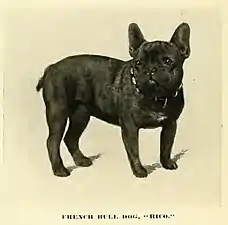 1890
1890 1901, Maurice in New York City
1901, Maurice in New York City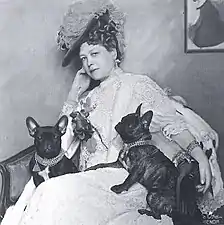 1908, Anna Sacher
1908, Anna Sacher_(14760460261).jpg.webp) 1911, Ch. Stanmore Argus
1911, Ch. Stanmore Argus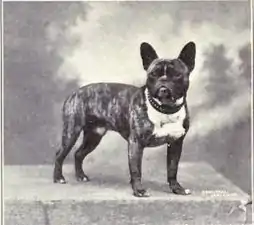 1915
1915.jpg.webp) between 1875 and 1917
between 1875 and 1917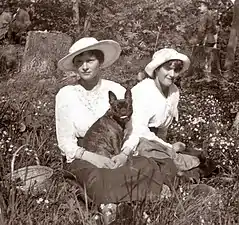 1917 with Grand Duchesses Tatiana and Anastasia Nikolaevna of Russia
1917 with Grand Duchesses Tatiana and Anastasia Nikolaevna of Russia
Description
The American Kennel Club standard for the French Bulldog states that it should be muscular, with a soft and loose coat forming wrinkles.[7]
The AKC Standard weight for a French Bulldog is at maximum 28 pounds (13 kg).[17] The head of a French bulldog should be square shaped and large, with ears that resemble bat ears.[17] French bulldogs are a flat-faced breed.[18] Eyes that are AKC Standard approved for French Bulldogs are dark, almost to the point of being black; blue eyed French bulldogs are not AKC approved.[17] The coat of a French bulldog should be short haired and fine and silky.[18] Acceptable colors under the breed standard are the various shades of brindle, fawn, cream or white with brindle patches (known as "pied"). The fawn colors can be any light through red.[17] The most common colors are brindle, then fawn, with pieds being less common than the other colors.[19] The breed clubs do not recognize any other colors or patterns,[17] because some colors come linked with genetic health problems not usually found in the breed. These include blue coloration, which is linked with a form of alopecia (hair loss or baldness), sometimes known as "blue dog alopecia".[20] Even dogs that are not blue can develop "blue dog alopecia" or canine follicular dysplasia.
 Brindle
Brindle.jpg.webp) Pied
Pied Cream
Cream Fawn
Fawn Black
Black Gray
Gray
Temperament
The French Bulldog, like many other companion dog breeds, requires close contact with humans.[21] French Bulldogs are often kept as companions.[7] The breed is patient and affectionate with their owners, and can live with other dogs. French Bulldogs are agreeable dogs, and are human-oriented, which makes them easier to train, though they do have tendencies to be stubborn.[7]
They are ranked 58th in Stanley Coren's The Intelligence of Dogs.[22] There are certain exceptions to this average level of canine intelligence; a French Bulldog named Princess Jacqueline which died in 1934 was claimed to be able to speak 20 words, in appropriate situations.[23]
Health

.jpg.webp)
As a consequence of selective breeding, French Bulldogs are disproportionately affected by health related problems.[24]
Brachycephalic airway obstructive syndrome
The skull malformation brachycephaly was increased by breeding for the French Bulldog's short snout, which causes brachycephalic airway obstructive syndrome. As a result, French Bulldogs often have trouble getting enough air even at slight efforts like walking, and are prone to snoring and panting.[25][26] This happens because they have narrow nostril openings, a long soft palate, and fairly narrow tracheas.[26] This issue can lead to death in French Bulldogs if they are not undergoing proper treatment.[26] In order to treat these dogs and create a smoother airway to the lungs, a procedure must be done that takes out a portion of their soft palate.[26] The results of the procedure show a minimum of 60% better airway passage to the lungs.[26]
As they are a brachycephalic breed, French Bulldogs are banned by several commercial airlines due to the numbers that have died while in the air.[27] This is because dogs with snub noses find it difficult to breathe when they are hot and stressed. The temperature in a cargo space in an aircraft can rise as high as 30 °C (86 °F) when waiting on the runway.[28]
A study of the deaths of 30,563 dogs of different breeds in the United Kingdom in 2016–2020 found the French Bulldog to have a life expectancy at birth of 4.93 years, the lowest by a large margin of all breeds in the study, which found an average for all dogs of 11.23 years. [29]: 1 This same study indicates that the low life expectancy for French Bulldogs is possibly influenced by the increasing number of French Bulldogs present in the UK, increasing from 2,771 KC registered individuals in 2011 to 39,266 individuals in 2020, skewing the general population to be very young on average and biasing the data. [29]: 1 Analysis of data from Japan suggested that its life expectancy there is considerably higher, at 10.2 years.[29]: 6
In 2013, a UK Medical Study reviewed the health of 2228 French Bulldogs under veterinary care in the UK.[30] The study found that 1612 (72.4%) of these French Bulldog had at least one recorded health issue:[30] "The most common disorders recorded were ear infections (14.0%), diarrhea (7.5%) and conjunctivitis (3.2%). Skin problems were the most commonly reported group of disorders (17.9%)."[30]
Birth and reproduction
French Bulldogs sometimes require artificial insemination and, frequently, Caesarean section to give birth, with over 80% of litters delivered this way.[31][32]
Back and spine
French Bulldogs are prone to having congenital hemivertebrae (also called "butterfly vertebrae"),[33][34] which will show on an X-ray.[35]
In October 2010, the UK French Bulldog Health Scheme was launched.[26] The scheme consists of three levels: the first level, Bronze, designates a basic veterinary check which covers all the Kennel Club Breed Watch points of concern for the breed. The next level, Silver, requires a DNA test for hereditary cataracts, a simple cardiology test, and patella grading. The final level, Gold, requires a hip score and a spine evaluation. The European and UK French Bulldog fanciers and Kennel Clubs are moving away from the screw, cork-screw or 'tight' tail (which is an inbreed spinal defect), and returning to the short drop tail which the breed originally had.[36] The UK breed standard requires that the tail be "undocked, set low, thick at root, tapering quickly towards tip, preferably straight, and long enough to cover anus" and "never curling over back nor carried gaily".[37] The French Bulldog may develop skin fold dermatitis.[38]
References
- ↑ FCI breeds nomenclature: Bouledogue Français (101). Fédération Cynologique Internationale. Accessed November 2021.
- 1 2 3 4 FCI-Standard N° 101: French Bulldog (Bouledogue Français). Fédération Cynologique Internationale. Accessed November 2021.
- ↑ "French Bulldog Dog Breed Information & Characteristics". 27 December 2023.
- ↑ "Le bouledogue Français, Ses origines", 'Official breed club created in 1898 (fr)'
- 1 2 3 4 5 6 7 8 9 10 11 D. Caroline Coile (2005). French Bulldogs. Hauppauge, New York: Barron's. ISBN 9780764130311.
- 1 2 3 4 Robert Leighton (1907). The New Book of the Dog. London; New York: Cassell.
- 1 2 3 4 "Get to Know the French Bulldog", The American Kennel Club, retrieved 28 May 2014.
- ↑ "French Bulldog Dog Breed Information". American Kennel Club. Retrieved 31 January 2020.
- ↑ [staff] (4 February 2022). Looking back: A Sacramento heiress and Murder on the French Bulldog Express. Sacramento News & Review. Archived 30 June 2022.
- ↑ "History of the FBDCA". French Bull Dog Club of America. Retrieved 2 January 2019.
- ↑ "Top Twenty Breeds In Registration Order For The Years 2018 And 2019" (PDF). The Kennel Club (UK). Archived from the original (PDF) on 26 June 2020. Retrieved 23 June 2020.
- ↑ "AKC: Most Popular Dog Breeds of 2018". The American Kennel Club.
- ↑ "Top 10 dog breeds in Australia 2017. Don't worry, they're all adorable". NewsComAu. Retrieved 12 April 2017.
- ↑ "COMPARATIVE TABLES OF REGISTRATIONS FOR THE YEARS 2010 - 2019 INCLUSIVE" (PDF). The Kennel Club UK. Archived from the original (PDF) on 31 January 2020. Retrieved 18 May 2023.
- ↑ American Kennel Club 2013 Dog Registration Statistics Historical Comparisons & Notable Trends, The American Kennel Club, Retrieved 28 May 2014
- ↑ "Beloved and debated, French bulldog becomes top US dog breed". 15 March 2023. Retrieved 15 March 2023.
- 1 2 3 4 5 Club, American Kennel. "American Kennel Club - Dog Breed Standards" (PDF).
- 1 2 "French Bulldog Dog Breed Information". American Kennel Club.
- ↑ American Kennel Club (11 November 2014). The New Complete Dog Book: Official Breed Standards and All-New Profiles for 200 Breeds, 21st Edition. i5 Publishing. p. 912. ISBN 9781621870913.
- ↑ "Introducing the French Bulldog". French Bulldog Club of England. Archived from the original on 6 August 2011. Retrieved 14 October 2011.
- ↑ McCrave, Elizabeth A. (March 1991). "Diagnostic Criteria for Separation Anxiety in the Dog". Veterinary Clinics of North America: Small Animal Practice. 21 (2): 247–255. doi:10.1016/S0195-5616(91)50030-9. PMID 2053248.
- ↑ Coren, Stanley (2006). The Intelligence of Dogs. London, UK: Pocket Books. p. 124. ISBN 978-1-4165-0287-6.
- ↑ "French Bulldoge That Could Talk Dies of Pneumonia". Telegraph Herald. Woodward Communications, Inc. 16 October 1934. Retrieved 14 October 2011.
- ↑ "French Bulldog Study Shows Just How Badly Extreme Breeding Has Impacted Their Health". Newsweek. 15 December 2021.
- ↑ Pet Health Network: Brachycephalic Syndrome
- 1 2 3 4 5 6 "The French Bulldog – Statement of The Health of The Breed". French Bulldog Club of England. Retrieved 1 June 2015.
- ↑ Haughney, Christine (6 October 2011). "Banned by Many Airlines, These Bulldogs Fly Private". New York Times. Retrieved 8 October 2011.
- ↑ White, Madeleine (7 October 2011). "Why are cute, snub-nosed dogs being banned from flying?". The Globe and Mail. Phillip Crawley. Retrieved 14 October 2011.
- 1 2 3 Kendy Tzu-yun Teng, Dave C. Brodbelt, Camilla Pegram, David B. Church, Dan G. O’Neill (2022). Life tables of annual life expectancy and mortality for companion dogs in the United Kingdom. Scientific Reports. 12 (2022): article number 6415. doi:10.1038/s41598-022-10341-6.
- 1 2 3 "Demography and disorders of the French Bulldog population under primary veterinary care in the UK in 2013" https://cgejournal.biomedcentral.com/articles/10.1186/s40575-018-0057-9#Sec4
- ↑ Evans, Katy M.; Adams, Vicki J. (2010). "Proportion of litters of purebred dogs born by caesarean section". Journal of Small Animal Practice. 51 (2): 113–8. doi:10.1111/j.1748-5827.2009.00902.x. PMID 20136998.
- ↑ Pete Wedderburn (6 April 2009). "Why do over 80 per cent of Bulldog births happen by caesarian section?". The Daily Telegraph. Archived from the original on 13 August 2011. Retrieved 5 August 2010.
- ↑ "Hemivertebrae". Mar Vista Animal Medical Center. Archived from the original on 30 April 2015. Retrieved 21 December 2019.
- ↑ "Genetic welfare problems of companion animals: Hemivertebrae". Universities Federation for Animal Welfare (UK). Archived from the original on 12 March 2015. Retrieved 21 December 2019.
- ↑ "Hemivertebrae". Top Dog Animal Health. Retrieved 1 June 2015.
- ↑ "The Kennel Club Dog Health Group, Annual Report 2013, SPECIAL FEATURE - FRENCH BULLDOGS" (PDF). The Kennel Club (UK). Retrieved 1 June 2015.
- ↑ Breed standards: French Bulldog. London: The Kennel Club. Accessed August 2022.
- ↑ "Skin fold dermatitis in dogs". PDSA.org. Retrieved 5 March 2021.